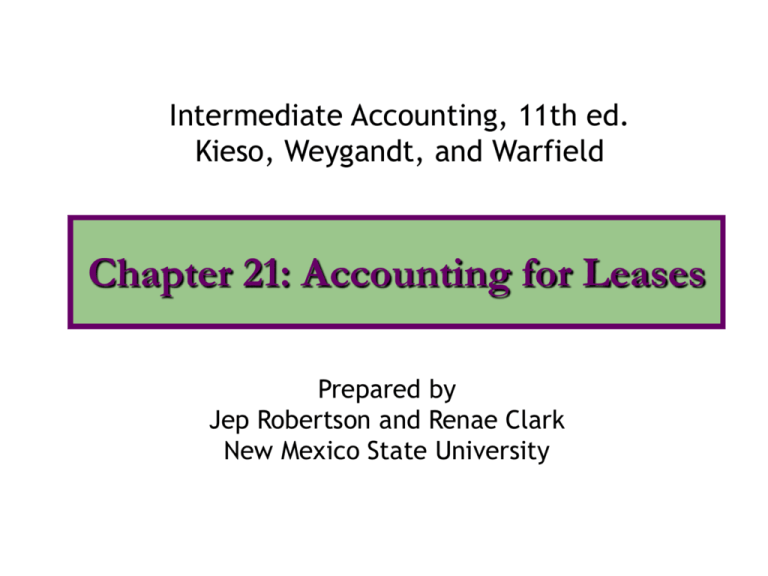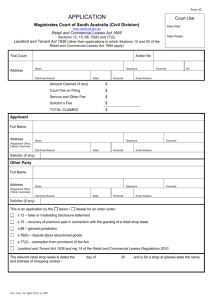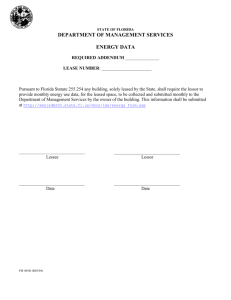
Intermediate Accounting, 11th ed.
Kieso, Weygandt, and Warfield
Chapter 21: Accounting for Leases
Prepared by
Jep Robertson and Renae Clark
New Mexico State University
Chapter 21: Accounting for Leases
After studying this chapter, you should
be able to:
1. Explain the nature, economic substance, and
advantages of lease transactions.
2. Describe the accounting criteria and
procedures for capitalizing leases by the lessee.
3. Contrast the operating and capitalization
methods of recording leases.
4. Identify the classifications of leases for the
lessor.
Chapter 21: Accounting for Leases
5. Describe the lessor’s accounting for
direct-financing leases.
6. Identify special features of lease
arrangements that cause unique
accounting problems.
7. Describe the effect of residual values,
guaranteed and unguaranteed, on lease
accounting.
8. Describe the lessor’s accounting for
sales-type leases.
9. Describe the disclosure requirements for
leases.
Teresa’s Additional Objectives
• Be able to classify a lease from the
perspective of lessor and lessee
• Be able to prepare journal entries for
lessor and lessee – for both operating
and capital-type leases
Leasing: Basics
• The lease is a contractual agreement
between the lessor and the lessee.
• The lease gives the lessee the right to use
specific property.
• The lease specifies the duration of the
lease and rental payments.
• The obligations for taxes, insurance, and
maintenance may be assumed by the lessor
or the lessee.
Advantages of Leasing
1. Leases may not require any money down.
2. Lease payments are often fixed.
3. Leases reduce the risk of obsolescence to
the lessee.
4. Leases may contain less restrictive
covenants than other types of lending
arrangements.
5. Leases may be a less costly means of
financing.
6. Certain leases may not add to existing
debt on the balance sheet.
Conceptual Nature of a Lease
According to the FASB:
• a lease transferring substantially all of the
benefits and risks of ownership should be
capitalized.
Transfer of ownership can be assumed only
if there is a high degree of performance to
the transfer, that is, the lease is noncancelable.
Leases that do not substantially transfers
benefits and risks are operating leases.
Accounting by Lessee
Leases that meet any of the
following four criteria are capital
leases for the lessee:
1. Leases, transferring ownership
2. Leases with bargain purchase options
3. Leases with lease terms equal to 75% or
more of the economic life (75% rule)
4. Leases where the present value of lease
payments is equal to 90% or more of the
fair market value (90% rule)
Accounting by Lessee
Lease Agreement
Is there transfer
of ownership?
No
Capital
Lease
Yes
Yes
Is there a bargain
purchase option?
No
Yes
Is lease term equal
to or greater than
75% of economic
life ?
Yes
No
Operating
Lease
Is present value
of payments
equal to or more
than 90% FMV?
The Bargain Purchase Option
A bargain purchase option
• allows the lessee to buy the leased asset
• at a price significantly lower than the
asset’s fair value when the option is
exercisable
The difference between the option price,
and the fair value (when the option is
exercisable) as determined at the
inception of the lease must render the
option reasonably assured.
The Recovery of Investment Test
(90% Test)
In determining the present value of the
lease payments, three important factors
are considered:
1) Minimum lease payments the lessee is
expected to make under the lease,
2) Executory costs (insurance, taxes, and
maintenance), and
3) Discount rate (used by the lessee to
determine the present value of minimum
lease payments)
Minimum Lease Payments
The minimum lease payments
include:
1) minimum rental payments (which may or
may not be equal to the minimum lease
payments)
2) guaranteed residual value at the end of
the lease term (guaranteed the lessor by
the lessee or a third party)
3) any penalty required of the lessee for
failure to extend or renew the lease
4) any bargain purchase option given to
lessee
Discount Rate
1. The lessee computes the present value of
the lease payments using the lessee’s
incremental borrowing rate.
2. If the lessee knows the lessor’s implicit
interest rate and it is less than the
lessee’s incremental rate, then such
implicit rate must be used.
3. The lessor’s implicit rate produces the
following result:
present value of (minimum lease payments and
unguaranteed residual value) = fair value of the
asset to lessor
Accounting for Asset and Liability
by Lessee
• In a capital lease transaction, the lessee
records an asset and a liability.
• The asset is depreciated by the lessee over
the economic life of the asset.
• The effective interest method is used to
allocate the rental payments between
principal and interest.
• Depreciation of the asset and discharge of
the lease obligation are independent
accounting procedures.
Classification of Leases: Lessor
Lessor classifies leases as one of the
following:
1. Operating lease
2. Direct financing lease
3. Sales-type lease
Accounting by Lessor:
Classification of Leases
To be classified as an operating lease:
1. The lease doesn’t meet any group 1
criteria (same as lessee’s), OR
2. Collectibility of payments isn’t reasonably
assured, OR
3. Lessor’s performance isn’t substantially
complete.
Accounting by Lessor:
Classification of Leases
To be classified as a direct financing lease
the lease must meet group 1 criteria
(same as lessee’s), and the following,
group 2 criteria:
1. Collectibility of payments must be
reasonably assured, and
2. Lessor’s performance must be substantially
complete, and
3. Asset’s fair value must be equal to lessor’s
book value
Lessor’s Criteria for Lease
Classification
Lease Agreement
Does lease meet
Group 1 criteria?
yes
No
Sales type
No
Is collectibility of
payments assured?
yes
No
Is lessor’s
performance
substantially
complete ?
No
yes
Operating
Lease
Direct
financing
Does asset FMV
equal lessor’s
book value?
yes
Operating Lease: Lessor
• The lessor depreciates the leased asset
according to its depreciation policy.
• Maintenance costs of the leased asset
(payable by lessor) are charged to expense.
• Initial Direct Costs, such as finder’s fees and
credit checks, are amortized over the lease
term.
• The leased equipment and accumulated
depreciation are shown as Equipment
Leased to Others.
Direct Financing: Lessor
The following information is needed by
lessor to record a direct financing lease:
Gross investment (lease payments receivable),
consisting of:
the minimum lease payments and any
unguaranteed residual value at the end of lease
term
Unearned interest revenue (difference between
gross investment and the FMV of the property)
Net investment (gross investment less unearned
interest revenue)
Direct-Financing Lease
Special Accounting Problems
•
•
•
•
•
•
Residual values
Sales-type leases (lessor)
Bargain purchase options
Initial direct costs
Current versus noncurrent
Disclosure
Residual Values
• Residual value is the estimated fair value of
asset at the end of lease term
• May either be guaranteed or unguaranteed
• From lessor’s perspective once the lease
rate is determined, it makes no difference
whether the residual value is guaranteed or
unguaranteed.
• From lessee’s perspective:
• Guaranteed residual affects minimum lease
payment calculation
• Unguaranteed residual does not
Sales-Type Lease
Initial Direct Costs
Two types:
• Incremental directs costs paid to third
parties at origination of lease
• Internal direct costs paid by lessor at
origination of lease.
Initial Direct Costs – TG’s Slide
Type of Lease
Operating
Direct Financing
Sales-type Lease
Accounting Treatment for
Initial Direct Costs
Recorded as an asset and
amortized over the lease
term
Recorded as part of
investment in lease and
amortized over lease term
by reducing interest
revenue
Immediately recognized as
an operating expense
(reduces manufacturer’s or
dealer’s profit
Example 10
Example 9
Example 6
Disclosure Requirements: Lessee
For the lessee, the requirements for
capital leases are:
• gross amount of assets
• future minimum lease payments
• total non-cancelable minimum sublease
rentals
• total contingent rentals
• identify assets separately
• general description of lessee’s
arrangements
Disclosure Requirements: Lessor
For the lessor, the requirements for
sales-type and direct-financing leases
are:
• components of net investment
• future minimum lease payments
• amount of unearned revenue included in
revenue
• total contingent rentals
• general description of lessor’s leasing
arrangements
Disclosure Requirements: Lessor
•
•
•
•
For the lessor, the requirements for
operating leases:
cost and carrying amount
minimum future rentals
total contingent rentals
general description of lessor’s leasing
arrangements
COPYRIGHT
Copyright © 2004 John Wiley & Sons, Inc. All rights reserved.
Reproduction or translation of this work beyond that permitted
in Section 117 of the 1976 United States Copyright Act without
the express written permission of the copyright owner is
unlawful. Request for further information should be addressed
to the Permissions Department, John Wiley & Sons, Inc. The
purchaser may make back-up copies for his/her own use only
and not for distribution or resale. The Publisher assumes no
responsibility for errors, omissions, or damages, caused by the
use of these programs or from the use of the information
contained herein.




